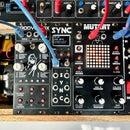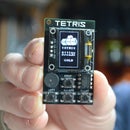Introduction: Portable, Solar 12V Battery Pack
Camping these days usually means bringing along things that need power. Usually I’d just use the cars 12v outlet but I find this a hassle, especially if you have to charge your phone at night.
So, after being inspired by a build my youngest brother did, I decided to build myself a battery pack that would last the whole time I was camping, was portable and also practical.
The battery pack runs off a 12v, SLA battery and has 3 outlets, one 12v cigarette outlet and 2 USB. An 18v solar panel ensures that it is kept charged throughout the camping trip and there is also LED lighting on the side with a dimmer. To regulate the power from the panel, I used a solar panel regulator. Lastly, I added a mains power switch to make sure the battery isn’t drained when not in use.
You can also charge the battery via a couple of lugs that stick out the side. I added these as an afterthought so you won't be able to see them in the images below. However I will add another step so show you how I did this soon
I use the power pack to run the shower (yes I have a portable, hot water shower. Nothing better than to have a hot shower after a couple days camping!), blow-up mattresses, charge up my portable speaker and phone, and whatever else that needs power.
The build isn’t very difficult; it does however require a little knowledge of electronics and some basic soldering skills. I’ll take you through all aspects of the build so anyone should be able to put one together.
Step 1: Parts and Tools
Parts:
1. 12v, 7ah SLA battery – eBay
2. Project or power box. The size I used was 85mm x 230mm x 150mm. You can buy these from electronic shops (Jcar in Australia) or eBay
3. 18v Solar Panel – eBay
4. 12v Solar panel regulator – eBay
5. On/off switch – eBay
6. Momentary switch – eBay
7. Red and black wire
8. LED strip – eBay
9. 12v Dual USB / Cigarette Charger – Ebay
10. Dimmer – eBay
11. Aluminium bar (for handle)
12. Double sided tape
13. Velcro
14. Various nuts and bolts
Tools
1. Drill
2. Angle grinder
3. Files
4. Hot glue
5. Soldering iron
6. Screwdrivers and Philips heads
Step 2: Attaching the Power Adapter
Steps:
1. Remove the voltage meter and power adapters and use the cowling as a template for the holes you need to drill into the project box
2. Mark out the hols onto the lid of the project box
3. Drill out the holes. I used a … sized hole bit to make the holes. They are slightly larger than needed to be so I had some room in case the drilling was off.
4. Next put the voltage meter and other adapters into the cowling and secure onto the lid with the plastic washers that they come with.
5. Screw the cowling to the project box lid
6. Lastly, drill a hole near the volt-meter and attach the momentary switch
Step 3: Attaching the Solar Panel
Steps:
1. Make a template out of a piece of paper, the same size as the solar panel
2. Mark the 2 solder points on the paper and stick it with tape to the lid.
3. Next, drill out the area where the pads are and remove the paper template
4. The solar panel that I used didn’t indicate which pad was negative and which was positive so I just used an LED, touched it to the pads, and put it up to a light source. Solder a couple of wires to the pads.
5. Attach some double sided tape to the back of the panel, thread the wires through the hole in the lid and stick the panel into place
Step 4: Adding the Mains Switch
Steps:
Mains Switch
1. Drill a hole in the side of the project box big enough to fit the switch into
2. Secure into place
Step 5: Attaching the Dimmer
Steps:
1. The dimmer switch comes in a small case. You need to remove the pot and circuit board from within.
2. First, un-screw the 4 screws holding the lid on
3. Next, remove the bolt holding the pot onto the lid
4. Carefully remove the lid and un-screw the circuit board from the case
5. Drill a hole in the side of the project box and attach the pot with the nut.
Step 6: Attaching the LED's
Steps:
1. Drill a hole in the project box for the wires on the LED light to go through. Remember to have the light close to the dimmer switch
2. Attach the LED’s to the project box. I had to modify my LED’s so they fitted correctly which meant that I couldn’t screw them in any longer to the project box. Instead I used some epoxy glue to secure it to the box. The LED’s also came with their own on/off switch so I didn’t have to worry about adding one. You may however need to add a switch if the ones you have chosen don’t have one
Step 7: Attaching the Handle
Steps:
1. I used a piece of aluminium strip to make the handle. First you need to bend one end.
2. Next, measure where to bend the other end, stick the aluminium into a vice and make the bend.
3. Trim off any excess aluminium
4. Secure it in place with some screws and lock nuts
Step 8: Wiring - Part 1 Battery
Steps:
1. The first thing to do is to secure your battery to the bottom of the box. Add some Velcro to the bottom of the battery and stick into place.
2. Next, you need to attach a wire from the positive terminal on the battery to one of the terminals on the main switch.
3. Another wire then needs to be attached to the other switch terminal to the solar panel regulator.
4. Lastly, attach a wire to the negative terminal and to the solar panel regulator
Step 9: Wiring Part 2 - Socket
Steps:
Ignore the LED wiring for the minute. I go through this in more detail in a couple of steps
1. Connect each of the terminals on the USB and 12v socket. Solder wires to each of the positive terminals and also the negative ones.
2. Solder another wire to one of the negative terminals on the socket to the terminal on the voltage meter.
3. On the other terminal on the voltage meter (positive one) solder a wire to it and then to one of the terminals on the momentary switch.
4. Solder a wire to the other terminal on the momentary switch and then secure this in the solar panel regulator as shown in the below image.
5. Attach wires to the last terminals on the socket and also secure these to the solar panel regulator.
Check out the diagram below to help you out with how to wire this section up. It’s pretty straight forward but might be a little confusing to a novice.
Step 10: Wiring - Part 3 Solar Panel
I have done some calculations which can be found below on how well the panel will charge the battery. If you got ideal sunlight for 6 hours, you should be able to recharge the battery by 25%. This should be enough to top-up the battery each day
Steps:
1. The wires that you soldered to the solar panel now need to be attached to regulator. On the regulator, there is a picture of a solar panel where you need to attach the wires (couldn't be more straight forward!)
2. Secure the wires (polarities the right way...) to the regulator
Thanks it!
Step 11: Wiring - Part 4 Dimmer and LED Light
Last thing to wire-up is the dimmer.
Steps:
1. Attach the wires from the LED light to the output section of the dimmer switch. Make sure that you have the polarities right.
2. Next add a red and black wire to the input section on the dimmer. These then need to go into the solar panel regulator as shown in the diagram below.
Step 12: External Lugs (For Charging)
There might be a need to top-up the battery now and then. I decided to add a couple of lugs to enable a battery charger to be attached. I didn't include these initially but after some comments, I thought it would be a good idea
Steps:
1. Drill a couple of holes into the side of the case. I made the holes slightly smaller than the screws (lugs) so I could add a thread to the inside of the holes.
2. Add a couple of bolts to the screws. these will be used to hold the wire to the screws.
3. Screw the screws into the holes.
4. Now attach a couple of wires to the battery terminals on the regulator and then attach them top the screws by wrapping them around them and tightening the bolts
5. Lastly, I added a couple of rubber covers I found at the hardware store. It's best if you can cover them when the battery is live as you don't want to accidentally short anything.
Step 13: Test and Close-up the Box
Now you have everything wired-up, it’s time to test and make sure all the electronics work. Plug the battery in and test that the power sockets are working. You should see a light on the USB 5v ones come on. Check the light as well and make sure it also comes on. If you can, test out the solar panel and make sure that the battery is getting charged. Lastly, make sure that the wires to the battery are secure and won’t come off if handled roughly.
Close-up the box and screw together.
DONE





